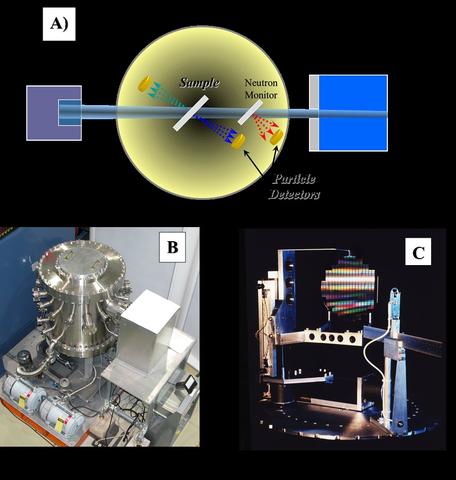Material Analysis Using Neutron Depth Profiling

Neutron Depth Profiling equipment: A) Schematic of the NDP system depicting reactions where a cold neutron beam passes through the vacuum chamber inducing charged particle reactions in the sample that are detected during analysis; B) Downward view of the NDP 61-cm-diameter stainless-steel chamber, vacuum pumps, and beam stop; C) View inside the NDP chamber with a 15-cm diameter silicon wafer mounted at the center and a charged particle detector positioned at the right side. All components are adjustable in position and angle.
Light elements such as helium, lithium, boron, and nitrogen are essential constituents in materials that enable energy technologies; lithium ion batteries, catalysts, solar silicon, and nuclear fusion. Neutron Depth Profiling (NDP), a nuclear analytical technique, determines both the amount and physical distribution of these elements usually in situ and without damage to the material. For example, with an intense beam of cold neutrons, lithium distribution is mapped dynamically as batteries are repeatedly charged and discharged. The data enables researchers to optimize battery structures and analyze failure mechanisms. The state-of-the-art NDP facility serves industry, academia, and government agencies at the NIST Center for Neutron Research (NCNR).
The video below is a 10 Minute Introduction to Neutron Depth Profiling
Specifications/Capabilities
The NDP instrument uses a > 1E+9 cm2/s thermal-equivalent neutron beam. Measurements occur in a high-vacuum chamber. Samples can be rastered in two dimensions with submicrometer resolution. Detection and quantitation limits are element dependent but typically range from 1E+12 to 1E+15 atoms/cm2. Electrical feed-through connections and heating stages are available in the chamber.
Scientific Opportunities/Applications
lithium ion batteries, boron in silicon, semiconductors dielectrics, optical waveguides, helium retention in fusion materials, element profiles in glass, catalysis, thin coatings
Related Publication
- Downing RG, Lamaze GP, Langland JK, Hwang ST. Neutron Depth Profiling: Overview and Description of NIST Facilities. Journal of Research of the National Institute of Standards and Technology. 1993;98(1):109-126. doi:10.6028/jres.098.008.
- Liu, D. X., Wang, J., Pan, K., Qiu, J., Canova, M., Cao, L. R. and Co, A. C. (2014), In Situ Quantification and Visualization of Lithium Transport with Neutrons. Angew. Chem. Int. Ed., 53: 9498–9502. doi:10.1002/anie.201404197

